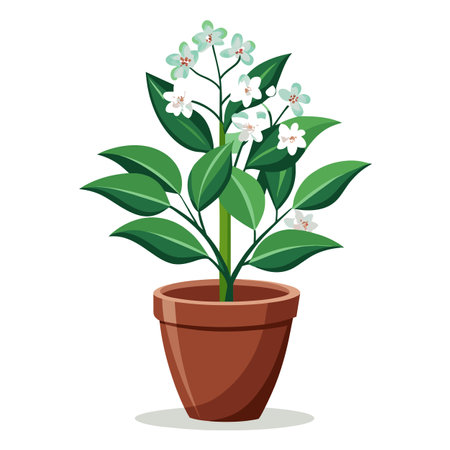Introduction to Houseplants and Their Popularity
Over the past decade, houseplants have experienced a remarkable surge in popularity across the United States. More Americans than ever are bringing greenery into their homes and workplaces, making indoor plants an essential element of modern interior design and lifestyle. This trend is driven by a combination of cultural shifts, such as the growing focus on wellness and mindfulness, as well as practical factors like urban living and limited access to outdoor spaces. Millennials and Gen Z, in particular, have embraced houseplant care as both a hobby and a form of self-expression, sharing their plant collections on social media platforms like Instagram and TikTok. Additionally, remote work and flexible office environments have motivated individuals to personalize their spaces with natural elements that foster comfort and creativity. As a result, houseplants are no longer just decorative accents; they have become valued companions that contribute to mental health, productivity, and overall well-being.
2. Houseplants and Mental Health Benefits
It’s no secret that life in the U.S. can be fast-paced and stressful, but bringing houseplants into your living space is a simple way to boost your mental well-being. Several scientific studies have shown that indoor plants can significantly reduce stress, anxiety, and symptoms of depression. According to a 2015 study published in the Journal of Physiological Anthropology, participants who interacted with houseplants experienced lower blood pressure and felt more relaxed than those who did computer tasks. This effect is particularly important for Americans who often juggle work, family, and personal obligations.
Many people across the country share real-life stories about how caring for plants provides emotional comfort and a sense of accomplishment. For example, during the COVID-19 pandemic, there was a surge in plant ownership as people sought ways to cope with isolation and uncertainty. The daily routine of watering, pruning, and watching plants grow offers structure and mindfulness—two key elements in managing mental health challenges.
The table below highlights some common mental health benefits reported by Americans who keep houseplants:
| Benefit | Description | Supporting Study or Experience |
|---|---|---|
| Reduced Stress | Interacting with plants calms nerves and lowers cortisol levels. | 2015 Journal of Physiological Anthropology study; anecdotal reports from urban professionals. |
| Less Anxiety | Caring for plants helps shift focus away from worries. | Pandemic-era plant parents report feeling calmer at home. |
| Decreased Depression Symptoms | Greenery and natural beauty provide uplifting visual stimulation. | Mental health counselors recommend plants for mood support. |
| Increased Mindfulness | The act of nurturing living things encourages presence in the moment. | Meditation instructors use plant care as a mindfulness exercise. |
For many Americans, houseplants are more than just decor—they’re an accessible form of self-care that brings peace and positivity into daily life. Whether you live in a city apartment or suburban home, adding a few green friends to your environment could make a meaningful difference for your mental health.

3. Boosting Productivity with Houseplants
As remote work becomes increasingly common across the United States, many people are searching for ways to enhance their home office environment. One simple and effective solution is incorporating houseplants into workspaces. Research has shown that the presence of greenery can significantly improve focus, boost creativity, and increase overall job satisfaction. For those spending long hours at a desk, adding a touch of nature may be the key to staying energized and motivated.
How Houseplants Enhance Work Performance
Houseplants help create a more inviting and comfortable workspace by reducing stress levels and promoting a sense of calm. This soothing effect can minimize distractions and support deeper concentration during complex tasks or virtual meetings. Additionally, the natural aesthetic provided by plants can inspire creative thinking—an important benefit for professionals in design, writing, or other creative fields.
Key Benefits of Houseplants in Workspaces
| Benefit | Description |
|---|---|
| Improved Focus | Plants reduce mental fatigue, making it easier to concentrate on work tasks for longer periods. |
| Increased Creativity | The presence of greenery stimulates fresh ideas and innovative problem-solving. |
| Higher Job Satisfaction | A well-designed workspace with plants fosters a positive mood and greater satisfaction with daily work routines. |
Relevant for the Work-from-Home Trend
With millions of Americans now working from home at least part-time, creating an optimal workspace has never been more important. Houseplants offer an affordable and accessible way to transform any room into a productive environment. Whether you choose a low-maintenance snake plant or a vibrant pothos, these living additions can make your workspace feel more personal, lively, and conducive to professional success.
Improvement of Indoor Air Quality
Houseplants do much more than just beautify our homes—they play a vital role in improving indoor air quality, which is particularly important in the United States where people spend a significant amount of time indoors. Many common houseplants are natural air purifiers, helping to filter out toxins and pollutants that can accumulate from everyday household products, furniture, and building materials.
How Houseplants Filter Toxins
Certain houseplants have been shown to absorb volatile organic compounds (VOCs) such as formaldehyde, benzene, and trichloroethylene, which are commonly found in paints, cleaning supplies, carpets, and even dry-cleaned clothes. Through their leaves and root systems, these plants break down harmful chemicals into harmless substances, contributing to a healthier living environment.
Increasing Oxygen Levels
In addition to filtering toxins, houseplants also increase oxygen levels indoors. During photosynthesis, plants take in carbon dioxide and release oxygen, creating fresher air for you to breathe. This is especially beneficial in well-insulated American homes where ventilation may be limited during colder months or extreme weather conditions.
Common U.S. Indoor Pollutants and Suitable Houseplants
| Pollutant | Source | Effective Houseplants |
|---|---|---|
| Formaldehyde | Furniture, pressed-wood products | Boston Fern, Spider Plant |
| Benzene | Paints, solvents, tobacco smoke | Peace Lily, English Ivy |
| Xylene & Toluene | Adhesives, nail polish remover | Bamboo Palm, Gerbera Daisy |
By strategically placing these houseplants around your home or office, you can target specific pollutants and enjoy cleaner indoor air. Not only do they help mitigate the effects of modern indoor living by reducing airborne toxins, but they also contribute to an overall sense of freshness and well-being within your space.
5. Choosing the Right Houseplants for Your Space
Selecting houseplants that thrive in your unique environment is essential for reaping their mental health, productivity, and air quality benefits. The right plant not only fits your décor but also matches your lifestyle and local conditions, making indoor gardening enjoyable and stress-free.
Tips for Selecting Low-Maintenance Houseplants
If you’re new to houseplants or have a busy lifestyle, opt for low-maintenance varieties that require minimal care. Look for plants that are forgiving of occasional neglect and can adapt to varying light conditions. Here’s a quick guide to some popular choices in the U.S.:
| Plant Name | Light Needs | Watering Frequency | Air Quality Benefits |
|---|---|---|---|
| Snake Plant (Sansevieria) | Low to Bright Indirect | Every 2-3 Weeks | Removes toxins like formaldehyde |
| Pothos (Epipremnum aureum) | Low to Medium Indirect | Weekly | Purifies air, easy to grow trailing plant |
| Spider Plant (Chlorophytum comosum) | Bright Indirect | Weekly | Absorbs carbon monoxide and xylene |
| ZZ Plant (Zamioculcas zamiifolia) | Low to Bright Indirect | Every 2-3 Weeks | Tolerates low light, cleans air |
Consider Local Climate and Light Conditions
Your region’s climate and the natural light available in your home play significant roles in plant selection. For example, succulents and cacti are ideal for bright, sunny windows, while ferns and peace lilies prefer shadier spots. If you live in a dry area or use air conditioning frequently, choose plants that tolerate low humidity.
Assessing Light Levels at Home
- South-facing windows: Provide the brightest light—great for succulents and cacti.
- East/West-facing windows: Moderate light—suitable for snake plants, pothos, or spider plants.
- North-facing windows: Low light—best for ZZ plants or philodendrons.
Health Factors: Pet-Friendly and Allergy Considerations
If you have pets or allergies, research which houseplants are safe and non-toxic. For example, spider plants are pet-friendly, while lilies can be toxic to cats. Always check labels or consult reliable sources when selecting new additions for your home.
Avoid Common Pitfalls
- Avoid overwatering by checking soil moisture before watering.
- Select pots with drainage holes to prevent root rot.
- Gradually acclimate new plants to their spot to reduce shock.
The right houseplant can boost your mood, improve focus, and purify indoor air—all while fitting seamlessly into your daily routine. Choose wisely based on maintenance needs, local conditions, and household safety for the best results.
6. Practical Tips for Incorporating Houseplants Into Daily Life
Bringing houseplants into your home or workspace can feel overwhelming at first, but with a few actionable strategies, anyone can enjoy the benefits of greener surroundings. Below are some practical tips tailored to American lifestyles, ensuring that houseplants are easy to maintain and enhance your daily routine.
Start Small and Choose Wisely
If you’re new to plant care, begin with low-maintenance species like snake plants or pothos. These are forgiving and thrive in various indoor conditions, making them perfect for busy households or small apartments.
Table: Beginner-Friendly Houseplants
| Plant Name | Light Needs | Watering Frequency | Common Placement |
|---|---|---|---|
| Snake Plant | Low to Bright Indirect | Every 2-3 weeks | Living Room Corner |
| Pothos | Low to Medium Indirect | Weekly | Bookshelf/Desk |
| Spathiphyllum (Peace Lily) | Medium Indirect | Weekly | Bedroom/Nightstand |
| Zamioculcas (ZZ Plant) | Low to Bright Indirect | Every 2-3 weeks | Office/Entryway Table |
Create a Routine That Fits Your Lifestyle
Add plant care to your weekly schedule—perhaps while listening to your favorite podcast or during Sunday morning coffee. Many Americans find that making plant care part of their self-care rituals boosts mindfulness and reduces stress.
Maximize Space in Homes and Workspaces
You don’t need a large home to enjoy houseplants. Use vertical space with hanging planters, wall-mounted shelves, or tiered plant stands. In workspaces, small succulents on desks or windowsills offer greenery without cluttering valuable workspace.
Table: Creative Placement Ideas for American Homes & Offices
| Location | Recommended Plants | Why It Works |
|---|---|---|
| Kitchen Windowsill | Basil, Mint, Aloe Vera | Culinary use + natural light access |
| Home Office Desk | Cactus, Spider Plant, Jade Plant | Compact size + air purification during work hours |
| Bathroom Shelf | Pothos, Ferns, Orchid | Loves humidity + brightens small spaces |
| Living Room Corner | Fiddle Leaf Fig, Rubber Plant, Monstera Deliciosa | Makes a statement + fills unused space elegantly |
| Dorm Room/Studio Apartment Wall Rack | Aloe Vera, English Ivy, Miniature Succulents | Saves floor space + adds personality to compact areas |
Leverage Community Resources and Technology
If you’re unsure where to start, local nurseries and gardening clubs often host workshops tailored for beginners. Apps like Planta or Blossom can send reminders and offer plant care guidance specific to your U.S. climate zone.
Troubleshooting Common Challenges in American Homes:
- If you have pets, choose non-toxic varieties like spider plants or Boston ferns.
- If sunlight is limited due to urban living or winter months, consider grow lights as an easy solution.
- If travel is frequent, invest in self-watering pots or ask a neighbor for occasional help—building community around plant care is a growing trend in many American neighborhoods.
The key is progress over perfection: even a single thriving houseplant can make a positive difference in mental health, productivity, and air quality. By choosing plants that fit your lifestyle and utilizing these practical tips, you’ll soon enjoy all the benefits that indoor greenery brings to modern American life.
7. Conclusion: Embracing Houseplants for a Healthier Lifestyle
As we have explored throughout this article, houseplants offer a range of benefits that go far beyond simple decoration. By bringing greenery into our homes and workspaces, we can significantly improve our mental health, boost productivity, and enhance indoor air quality. Scientific studies and personal experiences alike highlight the positive effects of nurturing plants—reducing stress, increasing focus, and filtering out harmful toxins from the air.
Summary of Houseplant Benefits
| Benefit | Description |
|---|---|
| Mental Health | Reduces stress, anxiety, and promotes feelings of calm and well-being |
| Productivity | Enhances concentration, creativity, and overall work performance |
| Air Quality | Removes toxins like formaldehyde and benzene, increases oxygen levels |
Encouragement to Add More Greenery
If you’re looking for a simple way to upgrade your lifestyle and create a healthier environment at home or in the office, consider adding more houseplants to your space. Whether you start with low-maintenance varieties like snake plants or pothos, or challenge yourself with more unique specimens, every bit of greenery helps. Not only will you enjoy the visual appeal, but you’ll also experience tangible improvements in how you feel and function each day.
Take Action Today
- Visit your local nursery or garden center to find plants that fit your lifestyle.
- Start small with one or two easy-care plants if you’re new to plant care.
- Share your love of plants with friends and family—houseplants make great gifts!
A Greener Tomorrow Starts at Home
Embrace the power of houseplants to transform your living and working spaces. With their proven benefits for mental health, productivity, and air quality, houseplants are an affordable and accessible way to invest in your well-being. Let’s create a greener, healthier future—one leaf at a time.


